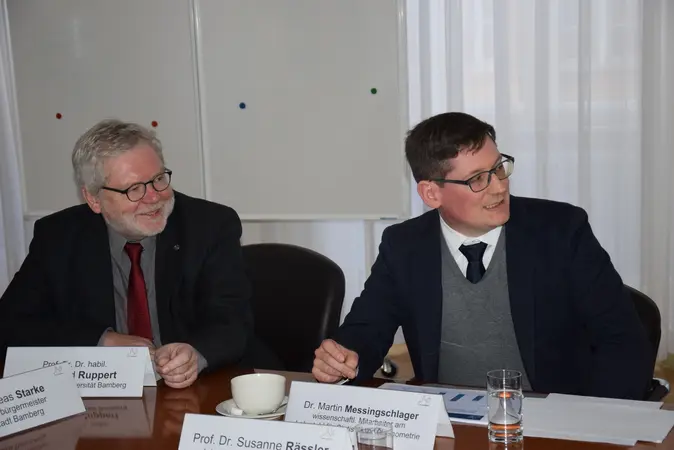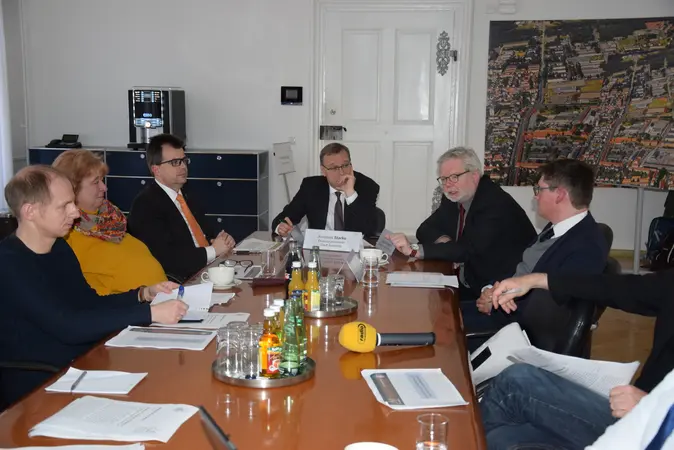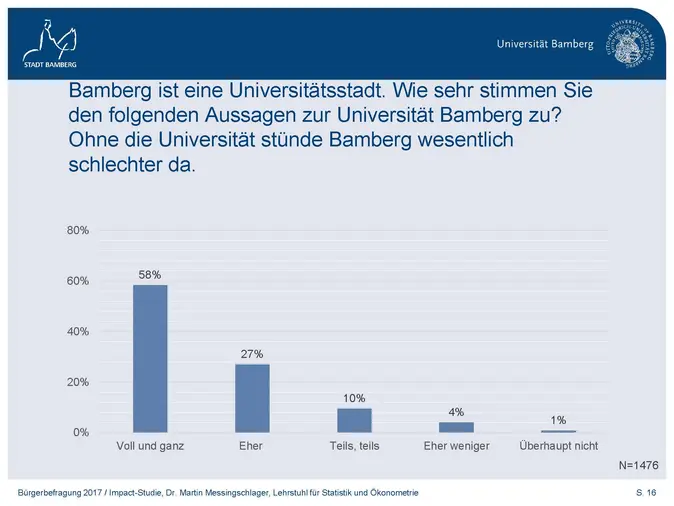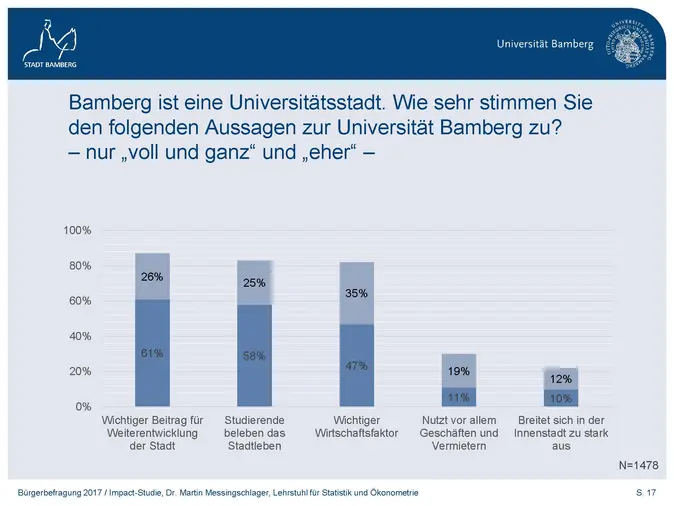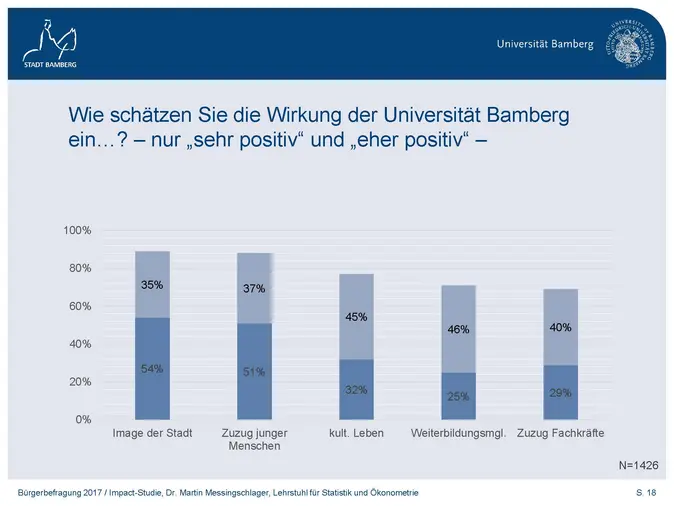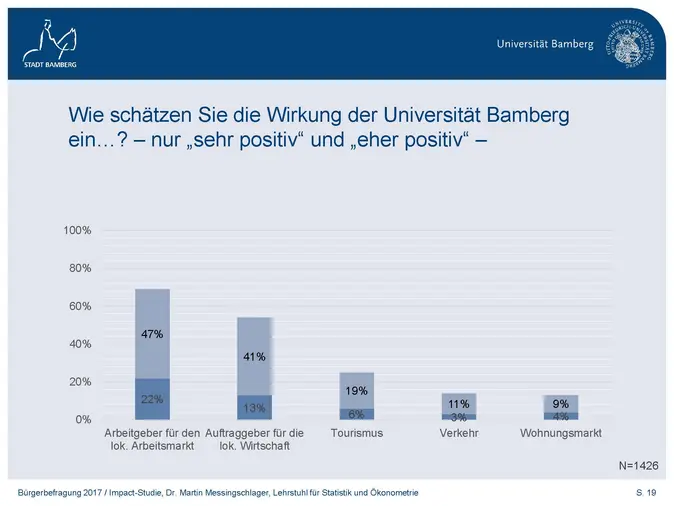Martin Messingschlager (right) and his team presented the findings of the first survey conducted jointly by the city and the university.
Together with University President Godehard Ruppert (2nd from right) and Lord Mayor Andreas Starke (3rd from right), the scholars offered a presentation on the study’s success and the positive feedback with regard to the university and city.
5,000 citizens were given the opportunity to participate in the survey.
Questions addressed topics like the role of the university in city life and the university’s contribution to the local economy.
Using the collected responses, the scholars were able to draw conclusions about how Bamberg residents view the effect of the university on the overall city image, on cultural life…
…and on the local labour market and tourism industry.
Results of the First Public Survey are In
What exactly do the citizens of Bamberg think about topics like the city’s leisure opportunities, the housing and employment situation, the integration of foreign citizens, educational opportunities and the role and impact of the university? This is what the first comprehensive public survey initiated by the City and University of Bamberg aimed to find out. On 1 March 2018, the project supervisors from the University of Bamberg presented their initial findings at an event attended by Lord Mayor Andreas Starke, Mayor Dr. Christian Lange and University President Prof. Godehard Ruppert.
Cooperation between the city, the university and local residents
Dr. Martin Messingschlager, research assistant at the University of Bamberg’s department of Statistics and Econometrics, and department chair Prof. Susanne Rässler came to the event bearing good news: approval ratings for current city policies and the university are high. And what’s more, even public participation was higher than average. From September to November 2017, 5,000 Bamberg citizens were given the opportunity to take part in the public survey either online or by post. Individual participants were selected at random by the city registry office – an established method whose high degree of data reliability ensures representative findings. Martin Messingschlager and Dr. Zoltán Juhász and his staff at the Bamberg Centre for Empirical Studies were responsible for the survey’s technical implementation. Sociologist Dr. Christoph Spörlein of the university’s Chair of Social Structure Analysis was in charge of the survey’s content and design. Spörlein and Messingschlager also headed the project.
In all, 32 percent of those contacted also responded to the project, meaning the project’s scholars evaluated 1,600 completed questionnaires. “It’s a terrific – and completely unexpected – response rate, especially considering that the average rate of participation in public surveys conducted at the municipal level hovers somewhere between 10 and 15 percent,” says Susanne Rässler. Martin Messingschlager was also quite pleased, adding, “The response rate shows that the citizens of Bamberg not only have a great interest in the topic, but that they also feel a motivation to help shape the development of their city.” Lord Mayor Andreas Starke sees this as yet another example of “the high level of Bamberg residents’ identification with their city”.
An “extraordinary trove of data” and outstanding findings
And it’s not merely the survey’s quantitative, but also its qualitative value that has brought a certain sparkle to the scholars’ eyes. Numerous questions were posed without answer prompts, because it was particularly important to the city and university to allow respondents space to offer their own personal appraisals. “We’re really pleased that so many people used the space to give highly detailed answers. This provides us with a truly extraordinary trove of data that future research and practical projects can draw on,” says Messingschlager. “Geographers, for example, could analyse the data with a focus on examining the living conditions of people in individual Bamberg neighbourhoods.”
Both the city and the university have praised the open-mindedness and the level of involvement with which the public approached the survey. Both sides are of course also pleased with the outstanding findings that for the first time afford a scientific view into the public’s thoughts on the city and the university. No less than 82 percent of respondents rated the quality of life in Bamberg as good or very good. Among the particular merits of life in the World Heritage city, cultural offerings, shopping facilities, the Hain Park, and the short distances between destinations all stood out. Three attributes are particularly popular among Bambergers describing their city (each approximately 80 percent): tradition-conscious, attractive and interesting. The city’s family-friendly offerings received excellent marks, but senior citizens and young adults also feel they’re in good hands. “We feel that this is a real confirmation of our efforts to make Bamberg a family-friendly city,” says Starke.
University valued as a part of the city
85 percent of respondents agreed with the assertion that, without the university, Bamberg would be considerably worse off. Between 82 and 87 percent agreed that the university represents a major economic factor, that the student population enlivens the city as a whole, and that the university is making a significant contribution to the city’s ongoing development. “This survey has supplied findings that are not only satisfying on a personal level, but that are also significant to our strategic approach to the future development of the university,” explains Godehard Ruppert. For example, the university received an important appraisal concerning the question of whether its expansion in the city centre is excessive. Only 22 percent of respondents had strong to slight reservations, whereas 56 percent saw little to no problem in this area. “Here, we can infer that the implementation of our University in the City facilities plan – which avoids a classic campus-based university concept in favour of integrated university spaces in the city centre – is being met with broad public acceptance,” says Ruppert.
Utilising proposals for the future
The survey also addressed current challenges like the housing market, parking spaces, traffic, and migration and integration. Lord Mayor Andreas Starke views the study’s findings not only as an endorsement of municipal efforts, but also as a call to action. “Naturally we’re pleased with the extremely positive feedback and the high level of citizens’ identification with the city of Bamberg, but we also know where the public is feeling squeezed. Those are the places we want to focus our energy. One good example is the approximately 3,000 new housing units that will be developed in Bamberg in the coming years. This will relax the extremely strained housing market and greatly increase the availability of affordable housing,” explains the mayor.
This news was translated by Benjamin Wilson.
